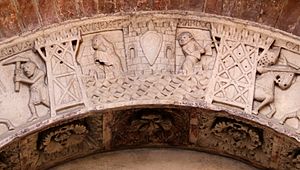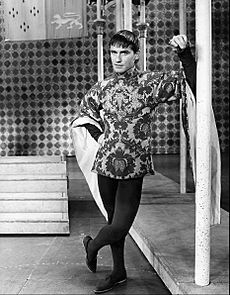Mordred facts for kids
Quick facts for kids Mordred |
|
|---|---|
| Matter of Britain character | |

Sir Mordred by H. J. Ford (1902)
|
|
| First appearance | Annales Cambriae (Medraut) Historia Regum Britanniae (Mo[r]dred) |
| Information | |
| Occupation | Usurper King of the Britons (a prince of Orkney and a knight of the Round Table in later tradition) |
| Title | Sir, Prince, King |
| Family | Parents: Arthur or Lot, Anna / Morgause Brothers: Gawain; often also Agravain, Gaheris and Gareth |
| Spouse(s) | Either Guinevere, Gwenhwyfach or Cwyllog |
| Children | Sometimes two sons including Melehan |
| Relatives | King Arthur's family |
| Nationality | Briton |
| Home | Lothian / Orkney, Camelot |
Mordred or Modred ( Welsh: Medraut or Medrawt) is a figure in the legend of King Arthur. The earliest known mention of a possibly historical Medraut is in the Welsh chronicle Annales Cambriae, wherein he and Arthur are ambiguously associated with the Battle of Camlann in a brief entry for the year 537. Medraut's figure seemed to have been regarded positively in the early Welsh tradition and may have been related to that of Arthur's son.
As Modredus, Mordred was depicted as Arthur's traitorous nephew and a legitimate son of King Lot.
Mordred is usually a brother or half-brother to Gawain; however, his other family relations, as well as his relationships with Arthur's wife Guinevere, vary greatly. In a popular telling originating from the French chivalric romances of the 13th century, and made prominent today through its inclusion in Le Morte d'Arthur, Mordred is knighted by Arthur and joins the fellowship of the Round Table. In this narrative, he eventually becomes the main actor in Arthur's downfall.
Contents
Name
The name Mordred, found as the Latinised Modredus in Geoffrey of Monmouth's Historia Regum Britanniae, comes from Old Welsh Medraut (comparable to Old Cornish Modred and Old Breton Modrot). It may be ultimately derived from Latin Moderātus, meaning "within bounds, observing moderation, moderate" with some influence from Latin mors, "death".
Early Welsh sources
The earliest surviving mention of Mordred (referred to as Medraut) is found in an entry for the year 537 in the chronicle Annales Cambriae (The Annals of Wales), which references his name in an association with the Battle of Camlann.
This brief entry gives no information as to whether Mordred killed or was killed by Arthur, or even if he was fighting against him.
An early 12th-century Italian high relief known as the Modena Archivolt seems to show a scene of abduction of Guinevere inspired by an original Welsh Arthurian tradition, perhaps as retold by Breton and other continental bards in their otherwise unrecorded oral stories. While often interpreted as that of Melwas, a mysterious figure identified as Mardoc may also represent Mordred.
Depictions in legend

In Geoffrey's Historia Regum Britanniae (The History of the Kings of Britain), written around 1136, Modredus (Mordred) is portrayed as the nephew of and traitor to King Arthur. Geoffrey might have based his Modredus on the early 6th-century "high king" of Gwynedd, Maglocunus (Maelgwn), whom the 6th-century writer Gildas had described as an usurper, or on Mandubracius, a 1st-century BC king of the Trinovantes. The unhistorical account presented by Geoffrey narrates Arthur leaving Modredus in charge of his throne as he crosses the English Channel to wage war on Lucius Tiberius of Rome. During Arthur's absence, Modredus crowns himself as King of the Britons. Arthur returns to Britain and they fight at the Battle of Camlann, where Modredus is ultimately slain. Arthur, having been gravely wounded in battle, is sent off to be healed by Morgen in Avalon.
Life in romances

The 12th-century early stories of the emerging chivalric romance genre such as those by Chrétien de Troyes, dealing with the adventures of various knights during Arthur's reign, would typically not mention Mordred at all. This changed through the 13th century, as the Old French cyclical romance literature greatly expanded on the history of Mordred prior to the war against Arthur. In the Prose Merlin part of the Vulgate Cycle (in which his name is sometimes written as "Mordret"), Mordred's elder half-brother Gawain saves the infant Mordred and their mother Morgause from being taken away as prisoners by the Saxon king Taurus. In the revision known as the Post-Vulgate Cycle, and consequently in Thomas Malory's English compilation Le Morte d'Arthur (The Death of Arthur), Arthur is told a cryptic (and, apparently, self-fulfilling) prophecy by Merlin about a just-born child that is to be his undoing, and so he tries to avert his fate by ordering to get rid of all May Day newborns. Whether they were intended to be killed or merely sent off to a distant land (the texts are vague about this), the ship on which the children were placed sinks and they drown. This episode, sometimes dubbed the "May Day massacre", leads to a war between Arthur and the furious King Lot, acting on his belief that he was biological father of Mordred. Lot dies in a battle at the hands of Arthur's vassal king Pellinore, beginning a long and deadly blood feud between the two royal families. Meanwhile, however, and unknown to both Lot and Arthur, the baby miraculously survives. It turns out Mordred was found and rescued by a fisherman and his wife, who then raise him as their own son until he is 14. In this branch of the legend, following his early life as a commoner, the young Mordred is later reunited with his mother, which happens long after Merlin's downfall caused by the Lady of the Lake.
In any case, the grown up Mordred becomes involved in the adventures of his brothers (having grown to become the tallest among them), first as a squire and then as a knight, as well as others such as Brunor. Eventually, he joins King Arthur's elite fellowship of the Knights of the Round Table. In the Prose Lancelot, he becomes a protege and companion of the eponymous great knight Lancelot. The older knight comes to the young Mordred's rescue on multiple occasions, such as helping to save his life at the Castle of the White Thorn (Castel de la Blanche Espine), and Mordred in turn treats the much older Lancelot as his personal hero. In this version, his turning point toward villainy happens after they meet an old hermit monk who begins to tell his own prophecy for the two "most unfortunate knights", revealing Mordred's true parentage by Arthur and predicting Mordred's and Lancelot's respective roles in the coming ruin of Arthur's kingdom. However, the angry Mordred kills the monk before he can finish. While Lancelot tells Guinevere (but not Arthur), she refuses to believe in the story of the prophecy and does not banish Mordred. The young knight, on his part, tries to get himself killed before accepting his destiny. The Prose Lancelot indicates Mordred was about 22 years old at the time, as well as just two years into his knighthood.
Eventually, Mordred overthrows Arthur's rule when the latter is engaged in the war against Lancelot (or during the second Roman War that followed it, depending on the version). In the Vulgate Mort Artu, Mordred achieves his coup with the help of a letter supposedly sent by the dying Arthur but actually forged by Mordred. The Mort Artu narration adds that "there was much good in Mordred, and as soon as he made himself elevated go the throne, he made himself well beloved by all," and so they were "ready to die to defend [his] honor" once Arthur did return with his army. Mordred's few opponents during his brief rule included Kay, who was gravely wounded by Mordred's supporters and died after fleeing to Brittany. In the Vulgate Mort Artu, Arthur proposes himself as a regent, while the French-influenced English poem Stanzaic Morte Arthur has council of Britain's knights first elects Mordred for the position in Arthur's absence as the most worthy candidate. The Alliterative Morte Arthure is a unique text in which Mordred is reluctant to be left by Arthur in charge of Britain. In the later romances, as in the chronicles, the returning Arthur's veteran army is ambushed and nearly destroyed by Mordred's supporters and foreign allies during their sea landing at Dover, where Gawain is mortally wounded while fighting as Arthur's loyalist. Afterwards, a series of inconclusive engagements follows, until both sides agree to all meet each other at the one final battle, in which Mordred typically fights exceptionally well while commanding the loyalty of thousands of men willing to lay down their lives for him against Arthur.
Death
In Henry of Huntingdon's retelling of Geoffrey's Historia, Mordred is killed at Camlann in a lone charge against him and his entire host by Arthur himself, who suffers many injuries in the process. In the Alliterative Morte Arthure, Mordred first kills Gawain by his own hand in an early battle against Arthur's landing forces and then deeply grieves after him. In the Vulgate Mort Artu (and consequently in Malory's Le Morte d'Arthur), the terrible final battle begins by accident during a last-effort peace meeting between him and Arthur. In the ensuing fighting, Mordred personally slays his cousin Ywain after the latter's rescue of the unhorsed Arthur. He also kills Sagramore in addition to six other Round Table knights loyal to Arthur in the Post-Vulgate depiction of the battle, which presents this as an incredible and unprecedented feat. These and many other versions of the legend feature the motif of Arthur and Mordred striking down each other in a duel after most of the others on both sides have died. Furthermore, the Post-Vulgate says it was only the death of Sagramore, here depicted as Mordred's own foster brother, that finally motivated Arthur to kill his son immediately afterwards.

"Then the king ran towards Sir Mordred, crying, 'Traitor, now is thy death day come.'"
There have been also alternative stories of Mordred's demise. Thomas Grey's Scalacronica attributes the killing of Mordred to Ywan (Ywain) at Camlann. In the Italian La Tavola Ritonda (The Round Table), it is Lancelot who kills Mordred at the castle of Urbano where Mordred has besieged Guinevere after Arthur's death. In Ly Myreur des Histors (The Mirror of History) by Belgian writer Jean d'Outremeuse, Mordred survives the great battle and rules with the traitorous Guinevere until they are defeated and captured by Lancelot and King Carados in London. Guinevere is then executed by Lancelot and Mordred is entombed alive with her.
Family relations
Traditions vary regarding Mordred's relationship to Arthur. Medraut is never considered Arthur's son in Welsh texts, only his nephew, though The Dream of Rhonabwy mentions that the king had been his foster father. In early literature derived from Geoffrey's Historia, Mordred was considered the legitimate son of Arthur's sister or half-sister queen named Anna or Gwyar and her husband Lot, the king of either Lothian or Orkney. Today, however, he is best known as Arthur's own illegitimate son.
Offspring
Since Geoffrey, Mordred is often said to be succeeded by his sons. Stories always number them as two, though they are usually not named, nor is their mother.
Modern portrayals
Mordred is especially prominent in popular modern era Arthurian literature, as well as in other media such as film, television, and comics. He has been played on screen by Leonard Penn (The Adventures of Sir Galahad, 1949), Brian Worth (The Adventures of Sir Lancelot, 1956–1957), David Hemmings (Camelot, 1967), Robert Addie (Excalibur, 1981), Nickolas Grace (Morte d'Arthur, 1984), Simon Templeman (The Legend of Prince Valiant, 1991–1993), Jason Done (Merlin, 1998), Craig Sheffer (Merlin: The Return, 2000), Hans Matheson (The Mists of Avalon, 2001), Asa Butterfield and Alexander Vlahos (Merlin, 2008–2012), and Rob Knighton (King Arthur: Legend of the Sword, 2017), among others.
Virtually everywhere Mordred appears, his name is synonymous with treason.
See also
 In Spanish: Mordred para niños
In Spanish: Mordred para niños
- Illegitimacy in fiction




